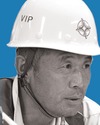But this project is unique in complexity because the tunnel sits between not one but two artificial islands, atop soft soil layers, Olsen adds. The deep tunnel lies well below an existing seabed, to make room for a future channel that will accommodate 300,000-tonne vessels. With an unusual width due to the six planned lanes, "it is a highly loaded tunnel that is very heavily reinforced," says Olsen.
 |
| LIN MING |
Thanks to such technology, crews placed, this July, the 11th of 33 tunnel elements into a carefully dredged trench, which has a slope gradient of up to 3%. Weighing over 75,000 tonnes each, the 180-m-long elements are on average 38 m wide and 10 m tall.
The 11th element was the first to be lowered into the bottom of the trench, which varies in depth along with the seabed levels. Engineers worried about the unknown effects of different current's velocities within the trench: about 1 m per second versus, at seabed level, 0.6 to 0.8 m per second, says Yin Haiqing, CCCC vice general engineer. "We constantly monitored the tunnel-element movement," he says.
The placement went smoothly. Before resuming work, the team celebrated with traditional banquets. At the end of August, the team also placed the twelfth element, Dong says.
Monster Piles
The bridge portions of the new crossing transition into the tunnel section via two nearly identical artificial islands. Each 625-m-long, 160-m-wide island is about 1,000 sq m, with soil layers as thick as 30 m. CCCC subsidiaries First Harbor Engineering Co. Ltd. and Third Harbor Engineering Co. Ltd. led construction of the western and eastern islands, respectively.
Peng Li Yan, president of First Harbor Engineering, says that, in 2009, it contacted American Piledriving Equipment (APE) to ask whether, to shave more than two years off construction, it would be possible to drive huge steel caissons, instead of sheet piles, to create the island perimeters.
"Our group cooperated once before with APE on the Yangtze River estuary project in 2003," Yan says. "In that case, we needed to drive a 13.4-meter- diameter concrete pile in as quick a manner as possible. But we had never driven a very large-diameter pile driven with a vibratory hammer."
CCCC's Fourth Harbor Engineering subsidiary had designed the Yangtze pile and urged pursuing the even bigger feat, Yan adds. "Nearly a year was spent convincing the [government] of the benefits of the large-diameter pile solution."
For Chinese engineers, says Lin Ming, CCCC chief engineer, "it was a new experience of solving world-class project problems. We forced ourselves to solve those problems with the help of international firms. But it's not just about setting records. It's about new technology for the industry."














Post a comment to this article
Report Abusive Comment